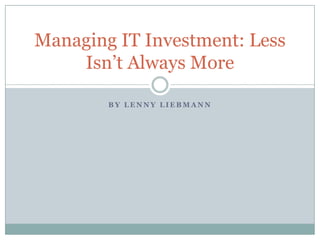Managing IT Investment
- 1. By Lenny LiebmannManaging IT Investment: Less Isnât Always More
- 2. ROI is More ImportantA high total cost of ownership (TCO) isnât necessarily bad when it comes to technology spending. Reasons why return on investment (ROI) is even more important.
- 3. Total Cost of OwnershipImplementationManagement Operation Costs
- 4. Business Interests Related to ITNot just about reducing expendituresBut also about increasingâĶGrowthInnovationReturn-on-capital
- 5. Value vs. InvestmentReductions in total cost of ownership do not translate to increased return-on-investment.Inexpensive may be ineffective.Aggressive investment can produce ROI.
- 6. TCO Figure Not Industry-WideCalculating an industry-wide TCO figure for any particular class of resource is problematic and probably pointless.Variations in configuration, utilization, scale, leading vs. trailing, IT staffing, regional and industry salary rates and other parameters vary.
- 7. Ratio of Two MetricsSC/RPE - Seat Cost over Revenue per EmployeeIntelligent Cost MetricPertinent to company differencesRPE is a useful metric for classifying companies.IT and line-of-business managers speak in terms of per-employee stats hence SC or Seat Cost.
- 8. Bringing ROI into the EquationLowering the ownership costs TCO does not necessarily mean increased return on investment ROI.
- 9. SC/RPE and ROIProportionally higher ownership costs could yield higher ROI.Business alignment, not raw costs, should be of primary concern to dollar-conscious IT managers.
- 10. ConclusionSC/RPE allows us to compare cost of ownership among dissimilar enterprises.Cost of ownership does not necessarily bear on ROI.
- 11. ReferencesLiebmann, L. (1998). Managing IT investment: Less isn't always more. Business Communications Review, 28(11), 52. Retrieved from EBSCOhost.











